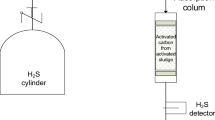Abstract
Surplus biological sludge from wastewater treatment operations was converted into activated carbon and then added to the aerated vessel of an activated sludge process treating phenol and glucose. The addition of activated carbon, either sludge-based or commercial, enhanced phenol removal from 58 to 98.7% and from 87 to 93% for COD with feed concentrations of 100 mg phenol l−1 and 2500 mg COD l−1. No differences were found between the activated sludge-activated carbon bench scale continuous reactors operating with either commercial or sludge-based activated carbon in spite of the higher adsorption capacity of the former.
Similar content being viewed by others
References
American Public Health Association, American Water Works Association, Water Pollution Control Federation (1992) Standard Methods for the Examination ofWater and Wastewater, 18th edn. Washington.
Apilánez I, Gutiérrez A, Diaz M (1998) Effect of surface materials on initial biofilm development. Bioresour. Technol. 66: 225-230.
Cohen Y (2001) Biofiltration-the treatment of fluids by microorganisms immobilised into the filter bedding material: a review. Bioresour. Technol. 77: 257-274.
de Jonge RJ, Breure AM, Andel JG (1996) Bioregeneration of powdered activated carbon (PAC) loaded with aromatic compounds. Water Res. 30: 875-882.
Ha S, Vinitnantharat S, Ozaki H (2000) Bioregeneration by mixed microorganisms of granular activated carbon loaded with a mixture of phenols. Biotechnol. Lett. 22: 1093-1096.
Jankowska H, Swiatkowski A, Choma J (1991) Active Carbon. New York: Ellis Horwood.
Johns MM, Marshall WE, Toles CA (1998) Agricultural byproducts as granular activated carbons for adsorbing dissolved metals and organics. J. Chem. Technol. Biotechnol. 71: 131-140.
Martin MJ, Balaguer MD, Rigola M (1996) Feasibility of activated carbon production from biological sludge. Environ. Technol. 17: 667-672.
Meidl JA (1997) Responding to changing conditions: how powdered activated carbon systems can provide the operational flexibility necessary to treat contaminated groundwater and industrial wastes. Carbon 35: 1207-1216.
Pollard SJT, Fowler GD, Sollars CJ, Perry R (1992) Low-cost adsorbents for waste and wastewater treatment: a review. Sci. Total Environ. 116: 31-52.
Sublette KL, Snider EH, Sylvester ND (1982) A review of the mechanism of powdered activated carbon enhancement of activated sludge treatment. Water Res. 16: 1075-1082.
Author information
Authors and Affiliations
Rights and permissions
About this article
Cite this article
Martin, M.J., Artola, A., Balaguer, M.D. et al. Enhancement of the activated sludge process by activated carbon produced from surplus biological sludge. Biotechnology Letters 24, 163–168 (2002). https://doi.org/10.1023/A:1014139414427
Issue Date:
DOI: https://doi.org/10.1023/A:1014139414427




